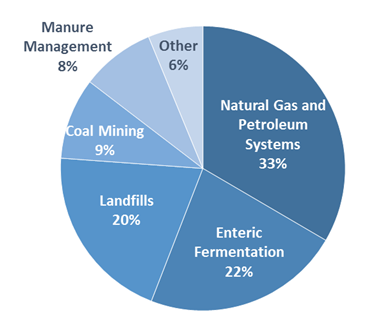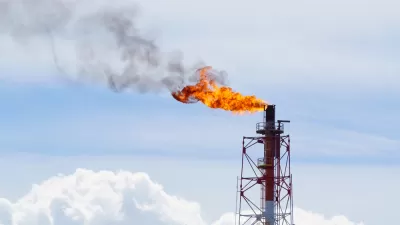President Barack Obama hopes to add to his "climate legacy" by having the EPA adopt the nation's first regulations to reduce methane emissions, the second most prevalent greenhouse gas emission after carbon dioxide, but far more powerful.
"The Obama administration announced an aggressive new plan Wednesday (Jan. 14) to combat global warming by targeting the methane emissions released through oil and gas production," writes Evan Halper of the Los Angeles Times.
The new regulations are only targeted (for now) at natural gas and petroleum activities which account for less than one third of U.S. methane emissions.

Credit: EPA
Note: All emission estimates from the Inventory of U.S. Greenhouse Gas Emissions and Sinks: 1990-2012. Enteric Fermentation refers to "methane released into the atmosphere from animal effluences" according to C2ES.
Methane emissions are currently controlled on a state level, allowing states to pursue regulation very differently. However, the energy industry is not happy with the idea of introducing federal regulations.
“Another layer of burdensome requirements could actually slow down industry progress to reduce methane emissions,” said American Petroleum Institute CEO Jack Gerard. [The Hill]
Methane, the main component of natural gas, accounts for "about 9% of all U.S. greenhouse gas emissions from human activities," according to the Environmental Protection Agency's webpage on methane emissions, which also indicates, "Pound for pound, the comparative impact of CH4 [chemical molecule for methane] on climate change is over 20 times greater than CO2 over a 100-year period."
Recent studies point to a higher number. Even the White House's press release and fact sheet on the new regulation states that it has “25 times the heat-trapping potential of carbon dioxide."
Prompting the regulation is the growth of the American energy sector, now the largest producer of natural gas in the world. Methane emissions have dropped 16 percent since 1990, but "emissions from the oil and gas sector are projected to rise more than 25 percent by 2025 without additional steps to lower them," according to the White House.
On the PBS NewsHour on Wednesday, Coral Davenport, energy and environment policy writer for The New York Times [see her piece], explains, "The president really wants to use these last two years of his term to build a legacy on climate change. He knows that he can’t move anything through Congress. He tried that in his first term, and it failed."
The LA Times' Harper adds, "The call for tighter controls on methane is part of Obama’s effort to use his executive authority under the Clean Air Act to confront global warming." In June, EPA release its plan to reduce emissions from existing power plants. The methane regulation, however, will be geared toward new wells, not existing ones.
Davenport writes that "the Interior Department is also expected to propose standards this spring that would reduce methane leaks from oil and gas wells on federal land."
A companion piece in the LA Times by environmental reporter Tony Barboza points to methane emissions that "are up to 61% higher than government estimates" in the Los Angeles basin. However, the source for the increased emissions is not known, though "scientists detected hot spots near major landfills."
Barboza points to a "study last year (that) found that natural gas drilling sites in Pennsylvania were releasing methane at rates 100 to 1,000 times greater than federal regulators had estimated."
FULL STORY: Obama administration moves to aggressively cut methane emissions

Alabama: Trump Terminates Settlements for Black Communities Harmed By Raw Sewage
Trump deemed the landmark civil rights agreement “illegal DEI and environmental justice policy.”

Study: Maui’s Plan to Convert Vacation Rentals to Long-Term Housing Could Cause Nearly $1 Billion Economic Loss
The plan would reduce visitor accommodation by 25% resulting in 1,900 jobs lost.

Why Should We Subsidize Public Transportation?
Many public transit agencies face financial stress due to rising costs, declining fare revenue, and declining subsidies. Transit advocates must provide a strong business case for increasing public transit funding.

Paris Bike Boom Leads to Steep Drop in Air Pollution
The French city’s air quality has improved dramatically in the past 20 years, coinciding with a growth in cycling.

Why Housing Costs More to Build in California Than in Texas
Hard costs like labor and materials combined with ‘soft’ costs such as permitting make building in the San Francisco Bay Area almost three times as costly as in Texas cities.

San Diego County Sees a Rise in Urban Coyotes
San Diego County experiences a rise in urban coyotes, as sightings become prevalent throughout its urban neighbourhoods and surrounding areas.
Urban Design for Planners 1: Software Tools
This six-course series explores essential urban design concepts using open source software and equips planners with the tools they need to participate fully in the urban design process.
Planning for Universal Design
Learn the tools for implementing Universal Design in planning regulations.
Smith Gee Studio
Alamo Area Metropolitan Planning Organization
City of Santa Clarita
Institute for Housing and Urban Development Studies (IHS)
City of Grandview
Harvard GSD Executive Education
Toledo-Lucas County Plan Commissions
Salt Lake City
NYU Wagner Graduate School of Public Service



























